Casablanca
| Casablanca الدار البيضاء (Arabic) Anfa, کازابلانکا |
|||
|---|---|---|---|
| ad-Dār al-Bayḍāʼ / Casablanca | |||
 |
|||
|
|||
| Nickname(s): Casa | |||
 |
|||
| Coordinates: | |||
| Country | Morocco | ||
| administrative region | Grand Casablanca | ||
| First settled | 7th century | ||
| reconstructed | 1756 | ||
| Area | |||
| - City | 324 km2 (125.1 sq mi) | ||
| - Urban | 1,615 km2 (623.6 sq mi) | ||
| Population (2010 est.) | |||
| - City | 5,550,000 | ||
| - Density | 9,132/km2 (23,651.8/sq mi) | ||
| - Urban | 7,500,000 (Grand Casablanca) | ||
| - Urban density | 2,383/km2 (6,171.9/sq mi) | ||
| Time zone | WET (UTC+0) | ||
| - Summer (DST) | WEST (UTC+1) | ||
| Postal code | 20000-20200 | ||
| Website | http://www.casablanca.ma/ | ||
Casablanca (Arabic: الدار البيضاء "ad-Dār al-Bayḍāʼ", original name in Amazigh: Anfa /![]() ) is a city in western Morocco, located on the Atlantic Ocean. It is the capital of the Grand Casablanca region.
) is a city in western Morocco, located on the Atlantic Ocean. It is the capital of the Grand Casablanca region.
With a population of over 5,500,000,[1] Casablanca is Morocco's largest city as well as its chief port. It's also the biggest city in the Maghreb. Casablanca is considered the economic and business center of Morocco, while the political capital city of Morocco is Rabat.
Casablanca hosts headquarters and main industrial facilities for the leading Moroccan and international companies based in Morocco. Industrial statistics show Casablanca retains its historical position as the main industrial zone of the country. The Port of Casablanca is one of the largest artificial ports in the world,[2] and the largest port of North Africa.[3] It is also the primary naval base for the Royal Moroccan Navy.
Contents |
Etymology
The Latinized name of the city, Casablanca, is a Spanish word combination meaning 'White House' (blanca, 'white;' casa, 'house'). It is thought that the Spaniards adopted the name from Portuguese Casa Branca. The city is now nicknamed Kaza by many locals.
The Berber original name, Anfa (meaning: "hill" in English), was used by the local, and Berber-speaking, city dwellers until the French occupation army entered the city in 1907 and adopted the Spanish name, Casablanca. "Anfa" now refers to the original old city quarters of Casablanca.
Legally speaking, Anfa is considered by the Moroccan government as a prefecture (a district) with a 0.5 million city dwellers, and is thus a part of the Grand Casablanca.
One of Casablanca's two civilian airports is called Casablanca-Anfa Airport, the other Mohammed V International Airport.
Geography
Casablanca is located in the Chawiya plain which has historically been the breadbasket of Morocco. The land where most of the city is located belonged to the Mediouna tribe.
Apart from the Atlantic coast, the Bouskoura forest is the only natural attraction in the city. The forest was planted in the 20th century and consists mostly of Eucalyptus and Pine tress. It is located half way to the city's international airport.
The only watercourse in Casablanca is Oued Bouskoura, a small seasonal creek that use to reach the Atlantic Ocean near the actual port. Most of Oued Bouskoura's bed has been covered due to urbanization and only the part south of El-Jadida Road can now be seen. The closest permanent river to Casablanca is Oum Er-Rbia River 70 km (43.50 mi) to the south-east.
History
Before the French Protectorate
The area which is today Casablanca was settled by Berbers by at least the 7th century.[4] A small independent kingdom, in the area then named Anfa, arose in the area around that time in response to Arab Muslim rule, and continued until it was conquered by the Almoravids in 1068.

During 14th century, under the Merinids, Anfa rose in importance as a port. In the early 15th century, the town became an independent state once again, and emerged as a safe harbour for pirates and privateers, leading to it being targeted by the Portuguese, who destroyed the town in 1468.
The Portuguese used the ruins of Anfa to build a military fortress in 1515. The town that grew up around it was called "Casa Branca", meaning "White House" in Portuguese.
Between 1580-1640, Casa Blanca was part of Spain, and later it became part of Portugal again. The European Colonists eventually abandoned the area completely in 1755 following an earthquake which destroyed most of the town.
The town was finally reconstructed by sultan Mohammed ben Abdallah (1756–1790), the grandson of Moulay Ismail and ally of George Washington with the help of Spaniards from the nearby emporium. The town was called الدار البيضاء ad-Dār al-Bayḍāʼ (translation in Arabic of the original Spanish Casa Blanca that means white house).
In the 19th century, the area's population began to grow as Casablanca became a major supplier of wool to the booming textile industry in Britain and shipping traffic increased (the British, in return, began importing Morocco's now famous national drink, gunpowder tea). By the 1860s, there were around 5,000 residents, and the population grew to around 10,000 by the late 1880s.[5] Casablanca remained a modestly-sized port, with a population reaching around 12,000 within a few years of the French conquest and arrival of French colonialists in the town, at first administrators within a sovereign sultanate, in 1906. By 1921, this was to rise to 110,000,[6] largely through the development of bidonvilles.
French rule
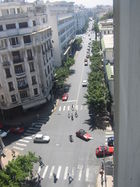
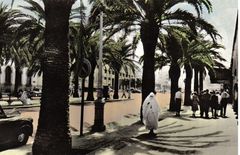
In June 1907, the French attempted to build a light railway near the port and passing through a graveyard. Residents attacked the French workers, and riots ensued. French troops were landed in order to restore order, which was achieved only after severe damage to the town. The French then took control of Casablanca. This effectively began the process of colonization, although French control of Casablanca was not formalised until 1910.
The famous 1942 film Casablanca underlined the city's colonial status at the time—depicting it as the scene of a power struggle between competing European powers, carried out with little reference to the local population. The film's vast cosmopolitan cast of characters (American, French, German, Czech, Norwegian, Bulgarian, Russian and some other nationalities) includes only a single (uncredited) local character, "Abdul" the doorman whose role is marginal.
During the 1940s and 1950s, Casablanca was a major centre of anti-French rioting. A terrorist bomb on Christmas Day of 1953 caused many casualties.
The Casablanca Conference
Casablanca was an important strategic port during the Second World War and hosted the Casablanca Conference in 1943, in which Churchill and Roosevelt discussed the progress of the war. Casablanca was the site of a large American air base, which was the staging area for all American aircraft for the European Theater of Operations during World War II.
Since independence
Morocco gained independence from France on the 2nd of March, 1956.
In 1930, Casablanca hosted a Grand Prix. The race was held at the new Anfa Racecourse. In 1958, the race was held at Ain-Diab circuit - (see Moroccan Grand Prix). In 1983, Casablanca hosted the Mediterranean Games.
The city is now developing a tourism industry. Casablanca has become the economic and business capital of Morocco, while Rabat is the political capital.
In March 2000, women's groups organized demonstrations in Casablanca proposing reforms to the legal status of women in the country. 40,000 women attended, calling for a ban on polygamy and the introduction of divorce law (divorce being a purely religious procedure at that time). Although the counter-demonstration attracted half a million participants, the movement for change started in 2000 was influential on King Mohammed VI, and he enacted a new Mudawana, or family law, in early 2004, meeting some of the demands of women's rights activists.
On May 16, 2003, 33 civilians were killed and more than 100 people were injured when Casablanca was hit by a multiple suicide bomb attack carried out by Moroccans and claimed by some to have been linked to al-Qaeda.
A string of suicide bombings struck the city in early 2007. A suspected militant blew himself up at a Casablanca internet cafe on March 11, 2007. On April 10, three suicide bombers blew themselves up during a police raid of their safe house.[7] Two days later, police set up barricades around the city and detained two more men who had escaped the raid.[8] On April 14, two brothers blew themselves up in downtown Casablanca, one near the American Consulate, and one a few blocks away near the American Language Center. Only one person was injured aside from the bombers, but the Consulate was closed for more than a month.[9]
Climate
Casablanca has a very mild semi-arid Mediterranean climate (Dry-Summer Subtropical, Köppen climate classification Csb, but is well within the semi-arid climate classification (Köppen BSh). Most precipitation falls in the winter months. Casablanca's climate is strongly influenced by the cool currents of the Atlantic Ocean which tends to moderate temperature swings and produce a remarkably mild climate with little seasonal temperature variation and a lack of extreme heat and extreme cold.
| Climate data for Casablanca | |||||||||||||
|---|---|---|---|---|---|---|---|---|---|---|---|---|---|
| Month | Jan | Feb | Mar | Apr | May | Jun | Jul | Aug | Sep | Oct | Nov | Dec | Year |
| Average high °C (°F) | 17.1 (62.8) |
18.8 (65.8) |
19.7 (67.5) |
21.3 (70.3) |
22.2 (72) |
24.4 (75.9) |
26.2 (79.2) |
26.7 (80.1) |
25.5 (77.9) |
22.1 (71.8) |
19.8 (67.6) |
19.7 (67.5) |
22.0 (71.6) |
| Daily mean °C (°F) | 12.2 (54) |
14.7 (58.5) |
15.9 (60.6) |
17.0 (62.6) |
19.1 (66.4) |
21.5 (70.7) |
23.2 (73.8) |
24.0 (75.2) |
22.4 (72.3) |
18.6 (65.5) |
15.7 (60.3) |
15.3 (59.5) |
18.3 (64.9) |
| Average low °C (°F) | 7.2 (45) |
10.5 (50.9) |
12.0 (53.6) |
12.6 (54.7) |
16.0 (60.8) |
18.6 (65.5) |
20.1 (68.2) |
21.2 (70.2) |
19.3 (66.7) |
15.1 (59.2) |
11.5 (52.7) |
10.9 (51.6) |
14.6 (58.3) |
| Precipitation cm (inches) | 4.01 (1.579) |
0.0 (0) |
0.0 (0) |
4.37 (1.72) |
1.44 (0.567) |
0.0 (0) |
0.0 (0) |
0.07 (0.028) |
0.97 (0.382) |
6.74 (2.654) |
1.82 (0.717) |
1.057 (0.4161) |
29.99 (11.807) |
| Avg. precipitation days | 6 | 0 | 0 | 12 | 5 | 0 | 0 | 2 | 4 | 5 | 8 | 12 | 54 |
| Source: World Meteorological Organization (UN)[10] | |||||||||||||
Economy
The Grand Casablanca region is considered the locomotive of the development of the Moroccan economy. It attracts 32% of the country’s production units and 56% of industrial labor. The region uses 30% of the national electricity production. With MAD 93 billion, the region contributes to 44% of the Industrial production of the Kingdom. 33% of national industrial exportations, MAD 27 billions, which is comparably with US $ 3.6 billion, come from the Grand Casablanca. 30% of Moroccan banking network is concentrated in Casablanca.[11][12]
One of the most important Casablancan exports is phosphorate. Other industries include fishing, fish canning, sawmilling, furniture making, building materials, glass, textiles, electronics, leather work, processed food, spirits, soft drinks, and cigarettes.[13]
The Casablanca and Mohammedia seaports activity represent 50% of the international commercial flows of Morocco.[14]
Almost the entire Casablanca coast is under project, mainly the construction of huge entertainment centres between the port and Hassan 2nd Mosque, the Anfa Resort project near Megarama cinema which is a business, distraction and living centre, Morocco Mall, a giant distraction mall, and finally a complete renovation of the walkway coast to be finished in June 2009. The Sindbad park is planned to be totally renewed by rides, games and distraction services.[15]
Royal Air Maroc has its head office on the grounds of Casablanca-Anfa Airport in Casablanca.[16] In 2004 it announced that it was moving its head office from Casablanca to a location in Province of Nouaceur, close to Mohammed V International Airport.[17] The agreement to build the head office in Nouaceur was signed in 2009.[18]
Demographics
The population of Grand Casablanca was estimated in 2005 at 3.85 million. 98% live in urban areas. Around 25% of them are under 15 and 9% are over 60 years old. The population of the city is about 11% of the total population of Morocco. Grand Casablanca is also the largest urban area in the Maghreb.[19] The number of inhabitants is however disputed by the locals, who point to a number between 5 and 6 million, citing recent drought years as a reason for many people moving into the city to find work.
Judaism in Casablanca
There was a Sephardic Jewish community in Anfa up to its destruction by the Portuguese in 1468. Jews were slow to return to the town, but by 1750 the Rabbi Elijah Synagogue was built as the first Jewish synagogue in Casablanca. It was destroyed along with much of the town in the earthquake of 1755.[4]
Main sights

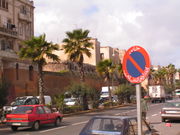
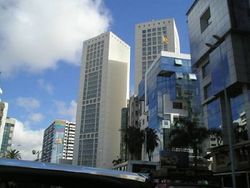

The French period New Town of Casablanca was designed by the French architect Henri Prost and was a model of a new town at that time. The main streets of the New Town (Ville Nouvelle in French) radiate south and east from Place des Nations Unies, where the main market of Anfa had been. The New Town is possibly the most impressive in Morocco. Former administrative buildings and modern hotels populate the area. Their style is a combination of Hispano-Mauresque and Art Deco styles.
Casablanca is home to the Hassan II Mosque, designed by the French architect Michel Pinseau. It is situated on a promontory looking out to the Atlantic, which can be seen through a gigantic glass floor with room for 25,000 worshippers. A further 80,000 can be accommodated in the mosque's courtyard. Its minaret is the world's tallest at 210 metres.
Work on the mosque was started in 1980, and was intended to be completed for the 60th birthday of the former Moroccan king, Hassan II, in 1989. However, the building was not inaugurated until 1993. Authorities spent an estimated $800 million in the construction of the building.
The Parc de la Ligue Arabe (formally called Lyautey) is the city's largest public park. On its edge is situated the Cathédrale Sacré-Coeur, which is disused, but is a splendid example of Mauresque architecture.
The Old Medina (the part of town pre-dating the French protectorate) attracts fewer tourists than the medinas of other Moroccan towns, such as Fes and Marrakech. However, it has undergone some restoration in recent years. Included in this project have been the western walls of the medina, its skala, or bastion, and its colonial-period clock tower.
Other sights
- Port of Casablanca
- Cathédrale Sacré-Coeur (Catholic Cathedral)
- City Hall
- Casablanca Technopark
- Casablanca Twin Center
Transport
Trains
Casablanca is served by two rail stations run by the national rail service, the ONCF. The main long haul station is Casa-Voyageurs, from which trains run south to Marrakech or El Jadida and north to Mohammedia and Rabat, and then on either to Tangier or Meknes, Fes, Taza and Oujda. A dedicated airport shuttle service to Mohammed V International Airport also has its primary in-city stop at this station, for connections on to further destinations.
The second station, Casa-Port, serves primarily commuter trains running the Casablanca - Kenitra corridor, with some connecting trains with running on to Gare de Casa-Voyageurs. www.oncf.ma
Coaches
CTM coaches (intercity buses) and various private lines run services to most notable Moroccan towns as well as a number of European cities. These run from the Gare Routière on Rue Léon l'Africain in downtown Casablanca.
Air
Casablanca's main airport is Mohammed V International Airport, Morocco's busiest airport. Regular domestic flights serve Marrakech, Rabat, Agadir, Oujda, and Tangier, Laayoune as well as other cities.
Casablanca is well served by international flights to Europe, especially French and Spanish airports, and has regular connections to North American, Middle Eastern and sub-Saharan African destinations. New York, Dakar and Dubai are important primary destinations.
The older, smaller Casablanca-Anfa Airport to the west of the city, that served certain destinations including Damascus, and Tunis, was largely closed to international civilian traffic in 2006. It currently services domestic flights and freight.
Taxis
Registered taxis in Casablanca are coloured red and known as petits taxis (small taxis), or coloured white and known as grands taxis (big taxis). As is standard Moroccan practice, petits taxis, typically small-four door Fiat Uno or similar cars, provide metered cab service in the central metropolitan areas. Grands taxis, generally older Mercedes-Benz sedans, provide shared mini-bus like service within the city on pre-defined routes, or shared inter-city service. Grands Taxis may also be hired for private service by the hour or day, although typically only foreigners do so.
Metro
An underground railway system is currently being projected, which when constructed will potentially offer some relief to the problems of traffic congestion and poor air quality. The metro will not be ready before 2017, having a length of 10 kilometers (6 miles) and costing 46.7 billion dirhams (approximately 5.8 billion USD).[20] However, it should be noticed that none of the preparatory works for this project have started. And, no discussion of it is observed in the media. The anecdote among Casablanca population is that "water is too near below, that they cannot dig tunnels."
Tram
A tram system is currently under construction should open in 2012.
Administrative divisions


Casablanca is a commune, part of the Region of the Grand Casablanca. The commune is divided into 8 districts (prefectures عمالات), which are themselves divided into 16 subdivisions (arrondissements دوائر) and 1 municipality (بلدية).
Districts
| Districts (fr: Préfectures d'arrondissement, ar: عمالة دوائر) | Subdivisions (fr: Arrondissements, ar: دوائر) | Municipalities (fr: Municipalités, ar: بلديات ) | Area | Population (2004) |
|---|---|---|---|---|
| عين الشق
Aïn Chock |
عين الشق
Aïn Chock |
28.89 km² | 253,496 inhabitants | |
| عين السبع الحي المحمدي
Aïn Sebaâ-Hay Mohammadi |
عين السبع
Aïn Sebaâ |
26.7 km² | 407,892 inhabitants | |
| الحي المحمدي
Hay Mohammadi |
||||
| الصخور السوداء / روش نوار
Roches Noires (Assoukhour Assawda) |
||||
| أنفا
Anfa |
أنفا
Anfa |
37.5 km² | 492,787 inhabitants | |
| المعاريف
Maârif |
||||
| سيدي بليوط
Sidi Belyout |
||||
| بن مسيك
Ben M'sick |
بن مسيك
Ben M'sick |
10.27 km². | 285,879 inhabitants | |
| سباته
Sbata |
||||
| سيدي) برنوصي)
(Sidi) Bernoussi |
سيدي) برنوصي)
(Sidi) Bernoussi |
38.59 km² | 453,552 inhabitants | |
| سيدي مومن
Sidi Moumen |
||||
| الفداء - مرس السلطان
Al Fida-Mers Sultan |
الفداء
Al Fida |
المشور
Mechouar |
17.9 km² | 332,682 inhabitants |
| مرس السلطان
Mers Sultan |
||||
| الحي الحسني
Hay Hassani |
الحي الحسني
Hay Hassani |
25.91 km² | 323,277 inhabitants | |
| مولاي رشيد
Moulay Rachid |
مولاي رشيد
Moulay Rachid |
13.38 km² | 384,044 inhabitants | |
| سيدي عثمان
Sidi Othmane |
Twin towns
 Tokyo, Japan, since 2004
Tokyo, Japan, since 2004 New York, USA, since 1998
New York, USA, since 1998 Paris, France
Paris, France Chicago, USA, since 1982[22]
Chicago, USA, since 1982[22] Dubai, United Arab Emirates
Dubai, United Arab Emirates Rome, Italy
Rome, Italy Montreal, Canada[23]
Montreal, Canada[23] Shanghai, People's Republic of China (1986)[24]
Shanghai, People's Republic of China (1986)[24] Athens, Greece
Athens, Greece Bordeaux, France, since 1988
Bordeaux, France, since 1988 Jakarta, Indonesia
Jakarta, Indonesia Kuala Lumpur, Malaysia[25]
Kuala Lumpur, Malaysia[25] Sosnowiec, Poland
Sosnowiec, Poland Saint Petersburg, Russia [26]
Saint Petersburg, Russia [26] Algiers, Algeria
Algiers, Algeria Artvin, Turkey
Artvin, Turkey Rize, Turkey
Rize, Turkey İstanbul, Turkey
İstanbul, Turkey İzmir, Turkey
İzmir, Turkey Alexandria, Egypt
Alexandria, Egypt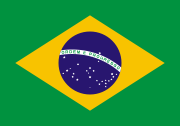 Rio de Janeiro, Brazil
Rio de Janeiro, Brazil
Education
Colleges and Universities
- University of Hassan II (Ain Chock)
- École Hassania des Travaux Publics
- ISCAE
- École supérieure de technologie de Casablanca
K through 12
- American Academy Casablanca
- Casablanca American School
- George Washington Academy
- Nelson C. Brown High School
- Babar land
- Lycée Lyautey
Sports
- Raja Casablanca
- Wydad Casablanca
People born in Casablanca
- Salaheddine Bassir - Moroccan footballer.
- Larbi Benbarek - Moroccan footballer.
- Jean-Paul Bertrand-Demanes - French footballer.
- Merieme Chadid - Moroccan astronomer.
- Jean-Charles de Castelbajac - French fashion designer.
- Nawal El Moutawakel - Olympic champion.
- Shatha Hassoun - Moroccan/Iraqi singer.
- Hicham Mesbahi - Moroccan boxer.
- Mostafa Nissaboury - Moroccan poet.
- Hakim Noury - Moroccan film director.
- Maurice Ohana - French composer.
- Jean Reno - French Hollywood actor.
- Alain Souchon - French songwriter.
- Sidney Taurel - Naturalized American CEO of Eli Lilly and Company from 1998 to 2008
- Richard Virenque - French cyclist.
- Abdallah Zrika - Moroccan poet.
- Gad Elmaleh - Moroccan-French One man show humorist/Actor.
In fiction
- Casablanca is the setting of the 1942 film of the same name starring Humphrey Bogart and Ingrid Bergman. The film has achieved worldwide popularity since then, having also won three Oscars and been nominated in five additional categories.
- The city is featured in The Mysterious Caravan, Volume 54 in the original Hardy Boys series.
- Casablanca is one of the key locations in the 2006 video game Dreamfall, as it is where the primary protagonist of the game, Zoë Castillo, lives.
- A Night in Casablanca (1946) was the twelfth Marx Brothers' movie. The film stars Groucho Marx, Chico Marx, and Harpo Marx. It was directed by Archie Mayo and written by Joseph Fields and Roland Kibbee. The film contains the song "Who's Sorry Now?" with music by Ted Snyder and lyrics by Bert Kalmar and Harry Ruby. It is sung in French by Lisette Verea playing the part of Beatrice Rheiner, and then later sung in English. Liszt's Hungarian Rhapsody No. 2 is played twice, once by Chico on piano as an intro to the Beer Barrel Polka, and again by Harpo on the harp.
- Casablanca is the setting for several chapters in Doubleshot, a 2000 James Bond Novel by Raymond Benson. In the novel one of the characters mentions that the 1942 film was shot in Hollywood and not on location.
References
- ↑ http://gazetteer.de/wg.php?x=&men=gpro&lng=fr&des=wg&geo=-134&srt=pnan&col=adhoq&msz=1500&pt=c&va=&geo=444977238
- ↑ "''Casablanca'' - ''Encyclopedia of the Orient''". Lexicorient.com. http://lexicorient.com/e.o/casablan.htm. Retrieved 2010-08-28.
- ↑ Discovering Casablanca - The Africa Travel Association
- ↑ 4.0 4.1 Jewish Virtual Library: Casablanca
- ↑ Pennel, CR: Morocco from Empire to Independence, Oneworld, Oxford, 2003, p 121
- ↑ Pennel, CR: Morocco from Empire to Independence, Oneworld, Oxford, 2003, p 149
- ↑ Terror Cell: 'Police Hold Fifth Man' April 12, 2007
- ↑ Casablanca on alert after suicide bombings April 12, 2007
- ↑ U.S. Shuts Morocco Consulate After Bomb April 15, 2007
- ↑ "Weather Information for Casablanca". http://www.worldweather.org/045/c00179.htm.
- ↑ (English) Casablanca, poumon économique du Maroc
- ↑ (French) http://www.casainvest.ma/casainvest/tabid/55/Default.aspx
- ↑ (French)http://www.topbladi.com/villes/casablanca.htm
- ↑ (English) [1]
- ↑ "votre partenaire pour investir à Casablanca au Maroc". CasaInvest.ma. http://www.casainvest.ma/. Retrieved 2010-08-28.
- ↑ "Non-airline partners." Royal Air Maroc. Retrieved on 19 October 2009.
- ↑ "Royal Air Maroc.(Africa/Middle East)(Brief Article)." Air Transport World. 1 July 2004. Retrieved on 19 October 2009.
- ↑ "Casablanca: Nouaceur abritera le futur siège de la RAM." L'Économiste. 18 August 2009. Retrieved on 19 October 2009.
- ↑ Casablanca.ma
- ↑ http://www.casablanca.ma/index/docs/deplacement_urbain_casa.pdf
- ↑ "La Préfecture de Casablanca (in French)". Casablanca.ma. http://www.casablanca.ma/index/html/html/prefecture-casa.html. Retrieved 2010-08-28.
- ↑ (French) Jumelage Casablanca-Chicago
- ↑ (French) Liste des protocoles et ententes internationales impliquant la ville de Montréal
- ↑ (French) Vers la concrétisation de l'accord de jumelage entre Shanghai et Casablanca
- ↑ Kuala Lumpur fact file, Asian-Pacific City Summit. Retrieved on December 31, 2007.
- ↑ (French) Russie - Maroc : les relations bilatérales ont fait leurs preuves
External links
- Official web site of Casablanca
- Online Casablanca Map - Indik.ma
- The Portal of Casablanca
- Official Casablanca Tourism Website (French)
- Casablanca entry in Lexicorient
- Tourist map
- US Consulate General
- France Consulate General
- Casablanca at the Magic Morocco
- Casablanca photo gallery
- Casablanca photo gallery (buildings and other landmarks with a history dating back to the French Protectorate)
- Song "Glittering Casablanca" and music video showcasing notable landmarks in Casablanca
|
||||||||||

